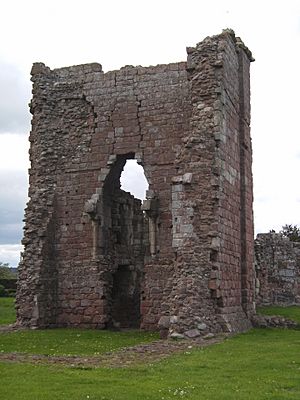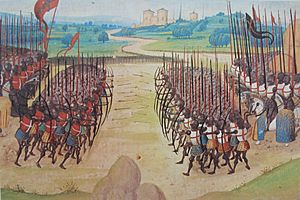Roger Corbet (died 1430) facts for kids
Roger Corbet (who died in 1430) was an English soldier, a leader in government, and a landowner. He was a supporter of Thomas FitzAlan, 12th Earl of Arundel. Roger likely fought in the famous Battle of Agincourt. After his patron, Arundel, died, Roger became a successful leader in the town of Shrewsbury. He was chosen to represent Shrewsbury twice and Shropshire once in the House of Commons of England, which is like today's Parliament.
Contents
Early Life and Family
Roger Corbet was the younger brother of Robert Corbet (1383–1420). They often worked together. Roger's exact birth date is not known, but he was born after 1383, as he was younger than Robert.
His parents were:
- Sir Roger Corbet of Moreton Corbet. The Corbet family had been important in the Welsh Marches (the borderlands between England and Wales) since the Norman Conquest in 1066.
- Margaret Erdington, daughter of Sir Giles Erdington from Warwickshire.
Roger's parents both died in 1395. His older brother, Robert, was not yet 12 years old. This meant Robert became a "ward," which meant someone else was in charge of his care and property until he was old enough. Robert's care was given to Thomas Percy, 1st Earl of Worcester, and later to John Burley. Both Robert and Roger became very close to Thomas FitzAlan, 12th Earl of Arundel, whose family supported the House of Lancaster (a royal family).
Roger's Public Life

Working with Arundel
Around 1405, Roger and Robert Corbet joined Arundel's group of supporters, known as his "affinity." They were called "esquires of the Earl of Arundel." Arundel had a lot of power because his father had been executed by King Richard II. This made Arundel and his uncle, Thomas Arundel, the Archbishop of Canterbury, strong supporters of the new King Henry IV.
In 1407, Roger and three others from Arundel's group gave a house in Shrewsbury to Shrewsbury Abbey. This was likely done for Arundel. Roger also helped John Talbot, who would later become the Earl of Shrewsbury, with his property. Roger attended elections for important county officials in 1410 and 1413. Arundel's group was becoming very powerful in these elections.
Challenges and Changes
When a new king, Henry V, came to power, many people complained about Arundel's strong-handed ways. John Talbot saw this as a chance to increase his own power. Roger Corbet was accused of breaking certain laws. He was also accused of taking property from a church leader's home in 1412.
These complaints led to a royal court session in Shrewsbury. However, Arundel helped his supporters, including Roger, get royal pardons. This meant they were forgiven for the accusations.
The Agincourt Campaign
In August 1415, the Corbet brothers went with Arundel to Normandy, France. This was part of the king's plan to claim the French throne. However, Arundel became sick during the Siege of Harfleur and had to return home to England, followed by Robert Corbet. Arundel died in October.
Roger seems to have stayed in France. There is no record of him leaving before the Battle of Agincourt. So, it is very likely that he fought in this famous battle.
Leading in Shrewsbury
After Arundel's death, Roger was no longer protected by him. He decided to focus on the town of Shrewsbury. The Corbet family owned several properties in the town, and some were given to Roger. This allowed him to be considered a "burgess," which meant he could hold town offices.
Shrewsbury was governed by two leaders, called "bailiffs," who were elected each year. They were helped by a council. Roger was elected as a bailiff on September 1, 1416, along with John Perle. They worked to improve tax collection in the town. Even though the town's rules usually allowed only one term for bailiffs, Roger and John were re-elected for the next year. They were also chosen as "coroners" (officials who investigate deaths) in 1418.
Working for the King
Roger then started to gain important jobs from the King. He became a commissioner for an investigation into the lands of the Barons FitzWarin. He was also made "escheator" of Shropshire, a job that could be quite profitable. In 1420, he became the Constable of Holt Castle, an important royal fortress on the border. In 1422, he was put in charge of 15 French prisoners of war.
Serving in Parliament
Roger Corbet was elected to Parliament for the first time in 1419, representing the borough of Shrewsbury. His brother Robert represented Shropshire at the same time. It was common for the town to elect current or recently retired bailiffs. Roger served in Parliament again for Shrewsbury in 1425. In 1429, he was elected as a "knight of the shire" for Shropshire, alongside William Burley.
Marriage and Family Life
Later in his life, Roger Corbet married Elizabeth, who came from a wealthy family. Elizabeth was the daughter of Sir William Lichfield and Elizabeth Cornwall.
Sir William Lichfield was a Member of Parliament for Worcestershire. He also served twice as the High Sheriff of Shropshire. He owned a lot of land in both counties.
Roger's mother-in-law, Elizabeth Cornwall, was related to King John through an illegitimate son of Richard, 1st Earl of Cornwall. Her father, Sir John Cornwall, was also a Shropshire MP. Elizabeth was his only heir. This meant Roger's wife would inherit a lot of property from both her wealthy parents.
However, Roger Corbet died early. He and Elizabeth Lichfield had only one daughter, Margaret. This meant Roger did not get to enjoy the wealth from his wife's inheritance for long.
Later Years and Death
Roger Corbet died on July 15, 1430. His daughter, Margaret, was only three years old. She became a "ward" of John Wood, a lawyer. Margaret later married Humphrey Stafford. Sir William Lichfield, Roger's father-in-law, lived much longer than Roger. Margaret did not inherit his estates until 1446.



